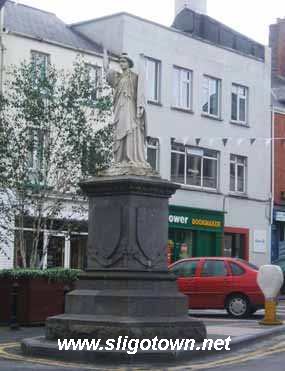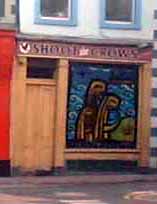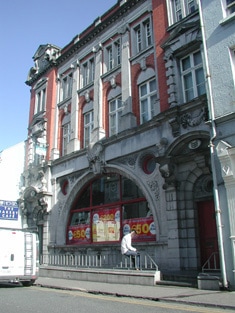
Overlooking the Market Cross, one of Sligo Town’s busier shopping areas, is the Lady Erin Monument, which was erected in 1899 to honour the centenary celebrations for those men who had fought in the Insurrection of 1798.
Designed by the Dublin sculptor Herbert G. Barnes, the memorial, which is over sixteen feet high, was unveiled on September 3rd 1898 in front of a crowd of several thousand people. Just to the right of the Lady Erin Monument you will see the “Shoot the Crows” public house, which features painted murals on the front window and inside there are more mysterious murals and skulls surrounding the bar. Whilst behind Lady Erin is the quaint 19th-century style Cosgrove’s grocery shop, if you have a few minutes to spare, it’s well worth having a look at the amazing array of foods which are displayed in a shop still living in a bygone age.  Continue a further 25 metres in the same direction, however Castle Street has now become Gratten Street a here you will see an impressive looking building on your right, this was formerly The Bank of Ireland Building. This attractive six-bay three-storey brick and stone building was designed by architect Ralph Byrne and built in 1918, making an important contribution to the local streetscape. It has been rumoured for many years that this building may be haunted by the ghost of a 30 year old Italian woman Rosa Di Lucia, who had been living in Sligo Town for only 2 years before she was savagely murdered in a bedroom above the ice cream and fast food premises which traded under the name of Macari & Co, which had existed on this site before the building of the Bank of Ireland building in 1916.
Continue a further 25 metres in the same direction, however Castle Street has now become Gratten Street a here you will see an impressive looking building on your right, this was formerly The Bank of Ireland Building. This attractive six-bay three-storey brick and stone building was designed by architect Ralph Byrne and built in 1918, making an important contribution to the local streetscape. It has been rumoured for many years that this building may be haunted by the ghost of a 30 year old Italian woman Rosa Di Lucia, who had been living in Sligo Town for only 2 years before she was savagely murdered in a bedroom above the ice cream and fast food premises which traded under the name of Macari & Co, which had existed on this site before the building of the Bank of Ireland building in 1916.  Rosa Di Lucia was brutally murdered on December 8th 1912, by her 30 year old husband Angelo Di Lucia, and 17 year old Ballymote girl Jane Reynolds who had been having an illicit affair, and had planned to carry out the murder in a bid to enable the two of them to continue their relationship unhindered. Leave the former Bank of Ireland building by continuing in the same westerly direction, and taking the next turn to your left up Harmony Hill, so named, according to local folklore,because the Garavogue River was, at one time, the place where all the towns women washed their family laundry, a place where rows often broke out. However, when Harmony Hill was first opened, it meant these women could get to the few washing spots on the river side without coming into conflict with each other, thus the town’s harmony was restored. At the crossroads at the top of Harmony Hill, turn around to admire the view back down to O’Connell Street and to Benbulben Mountain in the distance. Turn right at these crossroads and walk for 30 metres on your right, you will come to our next stop The Presbyterian Church and School. Click here to read about: The Presbyterian Church.
Rosa Di Lucia was brutally murdered on December 8th 1912, by her 30 year old husband Angelo Di Lucia, and 17 year old Ballymote girl Jane Reynolds who had been having an illicit affair, and had planned to carry out the murder in a bid to enable the two of them to continue their relationship unhindered. Leave the former Bank of Ireland building by continuing in the same westerly direction, and taking the next turn to your left up Harmony Hill, so named, according to local folklore,because the Garavogue River was, at one time, the place where all the towns women washed their family laundry, a place where rows often broke out. However, when Harmony Hill was first opened, it meant these women could get to the few washing spots on the river side without coming into conflict with each other, thus the town’s harmony was restored. At the crossroads at the top of Harmony Hill, turn around to admire the view back down to O’Connell Street and to Benbulben Mountain in the distance. Turn right at these crossroads and walk for 30 metres on your right, you will come to our next stop The Presbyterian Church and School. Click here to read about: The Presbyterian Church.
Comments are closed.